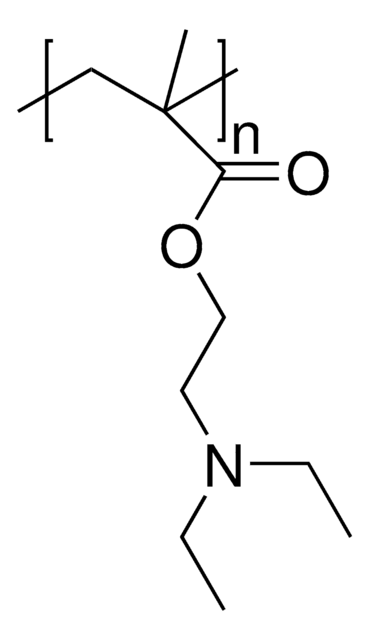910457
Poly(2-(diisopropylamino)ethyl methacrylate)
average Mn 10,000
Synonyme(s) :
Hydrophilic, PDPA, pH sensitive, pH-responsive
Se connecterpour consulter vos tarifs contractuels et ceux de votre entreprise/organisme
About This Item
Formule linéaire :
(C12H23NO2)n
Code UNSPSC :
12162002
Nomenclature NACRES :
NA.23
Produits recommandés
Forme
powder or solid
Poids mol.
average Mn 10,000 (by NMR)
average Mn 10,000
Couleur
white to faint yellow
PDI
≤1.3 (by GPC)
Température de stockage
2-8°C
Application
Poly(2-(diisopropylamino)ethyl methacrylate) is a pH-responsvie polymer. pH-Responsive polymers are a group of stimuli-responsive polymers that can respond to solution pH by undergoing structural and property changes such as surface activity, chain conformation, solubility, and configuration. The term “pH-responsive polymers” is commonly used to describe polymers having ionisable acidic or basic residues whose ionization depends on solution pH. The physical properties of the polymer, such as its chain conformation, configuration, and solubility, can be tailored by manipulating the pH or ionic strength. These unique properties of pH responsive polymer systems consequently make them very useful in various applications such as drug delivery, gene delivery, sensors, surfaces, membranes, and chromatography.
pH-sensitive polymer systems combined with nanotechnology could be utilized as an alternative strategy to traditional targeting systems to overcome major problems in current chemotherapy represented by non-specific tissue distribution of the drugs, tumor heterogeneity, and multidrug resistance (MDR) against anticancer drugs.
pH-sensitive polymer systems combined with nanotechnology could be utilized as an alternative strategy to traditional targeting systems to overcome major problems in current chemotherapy represented by non-specific tissue distribution of the drugs, tumor heterogeneity, and multidrug resistance (MDR) against anticancer drugs.
Code de la classe de stockage
11 - Combustible Solids
Classe de danger pour l'eau (WGK)
WGK 3
Point d'éclair (°F)
Not applicable
Point d'éclair (°C)
Not applicable
Certificats d'analyse (COA)
Recherchez un Certificats d'analyse (COA) en saisissant le numéro de lot du produit. Les numéros de lot figurent sur l'étiquette du produit après les mots "Lot" ou "Batch".
Déjà en possession de ce produit ?
Retrouvez la documentation relative aux produits que vous avez récemment achetés dans la Bibliothèque de documents.
pH-Responsive polymers
Kocak G, et al.
Polym. Chem., 8, 144-176 (2017)
Jing Xie et al.
Macromolecular rapid communications, 38(23), 1499-1499 (2017-10-05)
Since diabetes mellitus has become one of the most serious threats to human health, researchers have been designing new drugs and developing new technologies to control the blood glucose level (BGL) while improving patient compliance. In addition to the traditional
pH-sensitive polymers for drug delivery.
Huh K M, et al.
Macromolecular Research, 20(3), 224-233 (2012)
Girish Kumar Tripathi et al.
Current drug delivery, 8(6), 667-677 (2012-02-09)
Helicobacter pylori reside in the gastric mucus layer and at the mucus-epithelial cell interface wherein access of antimicrobial drug to the infection site is restricted both from the stomach and from the gastric blood supply. The aim of the present
Themis R Kyriakides et al.
Journal of controlled release : official journal of the Controlled Release Society, 78(1-3), 295-303 (2002-01-05)
Cytosolic delivery from endosomes is critical for those drugs that are susceptible to attack by lysosomal enzymes, such as DNA, RNA, oligonucleotides, proteins and peptides. Therefore, we have designed pH-sensitive, membrane-disruptive polymers to enhance the release of drugs from the
Notre équipe de scientifiques dispose d'une expérience dans tous les secteurs de la recherche, notamment en sciences de la vie, science des matériaux, synthèse chimique, chromatographie, analyse et dans de nombreux autres domaines..
Contacter notre Service technique




![N-[3-(Dimethylamino)propyl]methacrylamide 99%, contains MEHQ as inhibitor](/deepweb/assets/sigmaaldrich/product/structures/295/145/6b4aae15-7cb5-4b7b-9c06-8e6d24e50951/640/6b4aae15-7cb5-4b7b-9c06-8e6d24e50951.png)



![[2-(Methacryloyloxy)ethyl]trimethylammonium chloride solution 75 wt. % in H2O](/deepweb/assets/sigmaaldrich/product/structures/316/612/66b0f4cf-d060-427d-b4f5-e8fab3e5cffe/640/66b0f4cf-d060-427d-b4f5-e8fab3e5cffe.png)